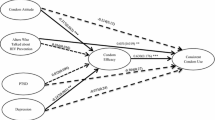Abstract
Research indicates that a large number of youth participate in risky sexual behaviors, including: having sex with multiple partners, not participating in discussions on safer sex practices, and not using condoms consistently when engaging in sexual activities. These behaviors put college students at an increased risk for human immunodeficiency virus, sexually transmitted infections, and unintended pregnancy. The purpose of this paper is to identify factors that may act as intra- and interpersonal barriers to condom use and to provide recommendations to increase condom use among college students. A review of the literature was performed which resulted in 15 articles identifying and discussing common barriers to condom use. Multiple factors were found to serve as barriers to condom use including (a) relationship dynamics; (b) perception of risk; and (c) gender roles. These barriers are summarized and recommendations are given to improve the rate of condom use among college students.
Similar content being viewed by others
References
Alvarez, M., & Garcia-Marques, L. (2011). Cognitive and contextual variables in sexual partner and relationship perception. Archives of Sexual Behavior, 40(2), 407–417.
American College Health Association. (2012). American College Health Association-National College Health Assessment II: Reference Group Executive Summary Spring 2012. Hanover, MD: American College Health Association.
Bailey, J., Haggerty, K., White, H., & Catalano, R. (2011). Associations between changing developmental contexts and risky sexual behavior in the two years following high school. Archives of Sexual Behavior, 40(5), 951–960. doi:10.1007/s10508-010-9633-0.
Baldwin, J. A., & Baldwin, J. D. (2000). Heterosexual anal intercourse: An understudied high-risk sexual behavior. Archives of Sexual Behavior, 29, 367–373.
Broaddus, M., Morris, H., & Bryan, A. (2010). ‘It’s Not What You Said, It’s How You Said It’: Perceptions of condom proposers by gender and strategy. Sex Roles, 62(9/10), 603–614. doi:10.1007/s11199-009-9728-z.
Carter, J. A., McNair, L. D., Corbin, W. R., & Williams, M. (1999). Gender differences related to heterosexual condom use: The influence of negotiation styles. Journal of Sex and Marital Therapy, 25(3), 217–225.
Centers for Disease Control and Prevention (2011). HIV among youth. Retrieved from http://www.cdc.gov/hiv/risk/age/youth/index.html.
Centers for Disease Control and Prevention (2012). Youth risk behavior surveillance—United States, 2011. Retrieved from http://www.cdc.gov/mmwr/preview/mmwrhtml/ss6104a1.htm?s_cid=ss6104a1_w.
Centers for Disease Control and Prevention (2013). Condoms and STDs: Fact sheet for public health personnel. Retrieved from http://www.cdc.gov/condomeffectiveness/latex.htm.
Centers for Disease Control and Prevention (2014). Male latex condoms and sexually transmitted diseases. Retrieved from http://www.cdc.gov/condomeffectiveness/latex.htm.
Civic, D. (2000). College students’ reasons for nonuse of condoms within dating relationships. Journal of Sex and Marital Therapy, 26(1), 95–105.
Flannery, D., Ellingson, L., Votaw, K., & Schaefer, E. (2003). Anal intercourse and sexual risk factors among college women, 1993–2000. American Journal of Health Behavior, 27, 228–234.
Frankel, A., & Curtis, D. (2008). What’s in a purse? Maybe a Woman’s Reputation. Sex Roles, 59(9/10), 615–622. doi:10.1007/s11199-008-9463-x.
Gullette, D. L., & Lyons, A. (2006). Sensation seeking, self-esteem, and unprotected sex in college students. Journal of the Association of Nurses in AIDS Care, 17(5), 23–31.
Lehmiller, J. J., VanderDrift, L. E., & Kelly, J. R. (2014). Sexual communication, satisfaction, and condom use behavior in friends with benefits and romantic partners. Journal of Sex Research, 51(1), 74–85. doi:10.1080/00224499.2012.719167.
Lewis, J. E., Malow, R. M., & Ireland, S. J. (1997). HIV/AIDS in heterosexual college students: A review of a decade of literature. Journal of American College Health, 45, 147–158.
Mikulincer, M., & Shaver, P. R. (2007). Attachment in adulthood—Structure, dynamics, and change. New York: Guilford.
Milhausen, R. R., McKay, A., Graham, C. A., Crosby, R. A., Yarber, W. L., & Sanders, S. A. (2013). Prevalence and predictors of condom use in a national sample of Canadian university students. Canadian Journal of Human Sexuality, 22(3), 142–151. doi:10.3138/cjhs.2316.
Patel, V. L., Yoskowitz, N. A., & Kaufman, D. R. (2007). Comprehension of sexual situations and its relationship to risky decisions by young adults. AIDS Care, 19(7), 916–922.
Schachner, D. A., & Shaver, P. R. (2004). Attachment dimensions and sexual motives. Personal Relationships, 11, 179–195.
Shearer, C., Hosterman, S., Gillen, M., & Lefkowitz, E. (2005). Are traditional gender role attitudes associated with risky sexual behavior and condom-related beliefs? Sex Roles, 52(5/6), 311–324. doi:10.1007/s11199-005-2675-4.
Strachman, A., & Impett, E. A. (2009). Attachment orientations and daily condom use in dating relationships. Journal of Sex Research, 46(4), 319–329.
Umphrey, L., & Sherblom, J. (2007). Relational commitment and threats to relationship maintenance goals: Influences on condom use. Journal of American College Health, 56(1), 61–68.
Vail-Smith, K., Whetstone, L., & Knox, D. (2010). The illusion of safety in “monogamous” undergraduate relationships. American Journal of Health Behavior, 34(1), 12–20.
Woolf, S. E., & Maisto, S. A. (2008). Gender differences in condom use behavior? The role of power and partner-type. Sex Roles, 58(9/10), 689–701.
Young, M., Penhollow, T. M., & Bailey, W. C. (2010). Hooking-up and condom provision: Is there a double standard? American Journal of Health Studies, 25(3), 156–164.
Author information
Authors and Affiliations
Corresponding author
Rights and permissions
About this article
Cite this article
Fehr, S.K., Vidourek, R.A. & King, K.A. Intra- and Inter-personal Barriers to Condom Use Among College Students: A Review of the Literature. Sexuality & Culture 19, 103–121 (2015). https://doi.org/10.1007/s12119-014-9249-y
Published:
Issue Date:
DOI: https://doi.org/10.1007/s12119-014-9249-y



